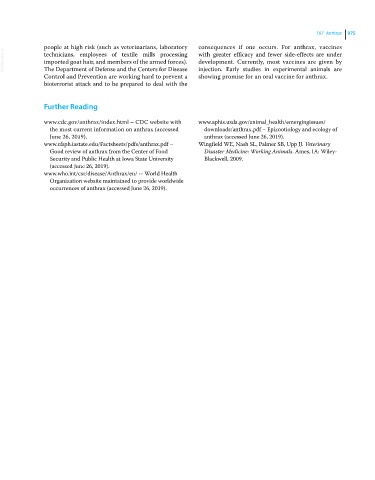Page 1037 - Clinical Small Animal Internal Medicine
P. 1037
107 Anthrax 975
people at high risk (such as veterinarians, laboratory consequences if one occurs. For anthrax, vaccines
VetBooks.ir technicians, employees of textile mills processing with greater efficacy and fewer side‐effects are under
development. Currently, most vaccines are given by
imported goat hair, and members of the armed forces).
The Department of Defense and the Centers for Disease
showing promise for an oral vaccine for anthrax.
Control and Prevention are working hard to prevent a injection. Early studies in experimental animals are
bioterrorist attack and to be prepared to deal with the
Further Reading
www.cdc.gov/anthrax/index.html – CDC website with www.aphis.usda.gov/animal_health/emergingissues/
the most current information on anthrax (accessed downloads/anthrax.pdf – Epizootiology and ecology of
June 26, 2019). anthrax (accessed June 26, 2019).
www.cfsph.iastate.edu/Factsheets/pdfs/anthrax.pdf – Wingfield WE, Nash SL, Palmer SB, Upp JJ. Veterinary
Good review of anthrax from the Center of Food Disaster Medicine: Working Animals. Ames, IA: Wiley‐
Security and Public Health at Iowa State University Blackwell, 2009.
(accessed June 26, 2019).
www.who.int/csr/disease/Anthrax/en/ ‐‐ World Health
Organization website maintained to provide worldwide
occurrences of anthrax (accessed June 26, 2019).

